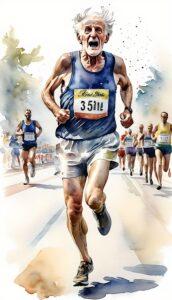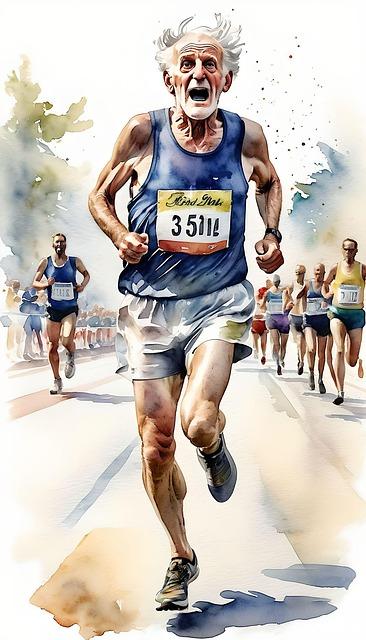Pre-Race Report – Mesa Marathon
 I keep wanting to capitalize all the letters in ‘Mesa’ when I type it. It just feels like one of those abbreviations that we use in business all the time.
I keep wanting to capitalize all the letters in ‘Mesa’ when I type it. It just feels like one of those abbreviations that we use in business all the time.
But it isn’t.
And I won’t.
I write to you from the Monday morning in Massachusetts.
Race day is early Saturday morning next.
I’m sitting at my office desk, which is actually a folding table in what used to be my oldest daughter’s bedroom. I set it up some time in the Covid era after the kids left the nest.
I have a real desk. A nice big corporate desk from the ‘turn of the century’. I bought it second hand with a couple nice office chairs. During the dot.com crash the company I was working for shuttered the office I was working out of and fire-saled off all the furniture.
But, that desk is downstairs in my house and I lack the easy means to move it up here into what I have declared my office. Of course I have a plan to mov it.
I always have a plan. My mind is perpetually drunk with unrealized plans.
Because at the end of the day it is the unrealized plans that keep us getting up in the morning and putting one foot in front of the other. Marching towards some self-invented necessity like happy, neurotic zombies.
That’s the way it is with events for me. I need to have an event on the calendar. It needs to be a worthy event, something big enough to keep me focused. The outcome needs to be uncertain enough to drive my behavior. The event, or the goal, or the ambition needs to connect to me both at the intellectual level and the physical challenge level.
Races are perfect for this event driven, behavior modification approach. Once you have the event in place on the calendar it forces you to ask a few questions. “What do I need to do to be successful?” and “What are the daily, weekly, monthly activities – or sub-goals – that will put me in a position to be successful?”
The answers to those questions are behavior modifying and lifestyle building. You end up with a plan you can wake up to and execute each day. The daily consistency then becomes lifestyle and identity.
Which, lacking any evidence to the contrary, as they say, I think is a good thing.
Out my window it is cold and sunny. We got another couple of inches of snow last night. Just enough to cover the cars and necessitate an hour of snow blowing and shoveling.
Want to hear a story?
We got a similar storm last week. I dutifully rolled out my snowblower and began to clear it. Towards the bottom of my driveway there is a strip of ground between the sidewalk and the road. It is a no-man’s land. Nothing can grow there. The soils is poor. It gets pounded with road salt.
A couple years ago my neighbors came up with a solution of filling this strip with decorative rocks. Maybe you’d call them pebbles. They are a bit bigger than a golf ball and oblong.
The problem is that they get pushed out by every storm and wayward plow into the road itself.
To continue the story, I sucked one of these up, it jammed the auger. Now snowblowers are designed for this. The auger has a shear bolt. Which dutifully sheared. But now I was without my snowblower.
Not a problem. I’ve got a backup snowblower. Which I started up and continued with my work. But this one hasn’t been used much, so it stalled, and when I went to restart it I broke the pull cord.
Neither of these are expensive or fatal fixes. On the one you just stick a new shear bolt through the hole. On the other you re-wrap the new cord. But for me they meant the end of the day’s automated snow removal. And they made me choose between doing the fixes myself like a red-blooded American male should or having them fixed.
I had them fixed.
…
Even though we have gotten through the darkest months of December and January, February is the coldest month. I’m getting used to the cold. My physiology is adapting. Like it always does. Cold adapted just in time to meet the warmer weather.
Today is Monday.
The race is Saturday.
Up until this point the race was a theoretical thing. Now it’s a real thing.
Frankly, I’ve always been better at training than racing. It’s probably a character flaw. Some innate lack of courage or self-doubt. But this week I get to live through my least favorite part of the process, arm-wrestling with pre-race anxiety.
…
This race was not my target race. My target race was a 100K trail race in Memphis in November. That was my big goal. It was a logical next step in the rehabilitation of my knee injury from 2020. 62 miles for my 62nd birthday. Perfect symmetry. Everything was going great.
Until the end of September when I tripped and broke my shoulder on an early morning trail run.
I was told to stay out of the woods until my shoulder knitted.
My big goal of the 100K on my Birthday was hastily rubbed off the calendar. But, as a behavior-modifying goal it had mostly done its job. When I asked myself in May ‘what do I need to do to be successful?’ The answer was lose a bunch of weight, and get some long, base trail miles in without re-injuring my knee. And get stronger.
Before I face-planted I worked with my coach Rachel (www.DrShuck.com) to get my nutrition under control and lost 30 pounds over the summer. I worked with my coach Jeff Kline at PRSFit to safely build my base and get strong and slowly build the miles.
When my shoulder hit the ground, I was healthy and fit. I was thrilled with what I had accomplished.
But then I needed to find a new goal – to save and extend this healthy streak.
That’s the way it works. If I couldn’t find a new goal all would evolve into chaos and anarchy.
Coach Jeff suggested the Mesa Marathon. It was in the right place on the calendar to get a good training cycle in and it was a downhill race where I could lower my finish time and see what the old body could do. Of course he wanted to trick me into training for a BQ.
I have mixed feelings about that whole BQ thing. I’ve run 22 Bostons. Boston is like an ex-lover. Makes me equal parts nostalgic and uncomfortable. Like getting a friend request from an ex-lover.
Now I needed to ask the questions again, “What do I need to do to race successfully at Mesa?” “What does ‘successfully’ even mean for me these days?”
The answer was I would need to transition from the trails back onto the road. I would need to maintain my healthy nutrition through the holidays and keep the weight off. I would need to do some quality marathon specific training. Some ‘real training’.
Sigh.
The wheel turns and I end up where I started.
And here we are.
Going back to September when the clavicle cracked, I was just entering the build for the November race. I had strength and volume. Theoretically all I needed to do was layer on some speed.
To put things in perspective, I’m not running a lot of miles at this age. I only run 3-4 times a week.
My September was 106 miles of running with 65 miles of cycling.
Then I had to take some time off for the shoulder and start over with road training.
In October I eased in with 77 miles of base building on the rail trail as I got used to the road again.
In November I built that up to 128 miles.
In December I put in 137 miles.
In January I lost a build week to a virus but still managed to load in 139 good miles of work including some crushing long tempo.
And here we are.
I also got the benefit of some real road racing terrain.
The rolling hills around my house. The snow and ice has closed the rail trail for these types of quality workouts. Which made the workouts more difficult, but also more beneficial.
I could have used one or two more weeks of build, but I’m very fit and lean. If anything, I’m over trained. And I probably couldn’t have made it through another couple big build weeks without throwing a piston.
Those last two weeks of long tempo were very hard. And at the end I did pick up some injuries.
I pulled something in my oblique in those last couple long runs. That made my stride a bit wonky.
And, most unfortunately, I have torn something in my heel in the last few runs.
This is very stressful. It’s not Plantar Fasciitis. It feels like some other stress injury in the soft tissue. Maybe a bursa tear.
There’s nothing I can do about it now. It is what it is. I’ll stay off my feet as much as possible this week and hope it heals enough to not cause too much trouble in the race.
But, as always, long time listeners will recognize the old familiar pattern, this is a repeat of what usually happens when I push too hard. Push until I break.
I am Sisyphus.
I feel like I’m too old and too neurotic to go all in for road marathons. When I come out of this one, I’ll need to think about how to proceed, and how to set goals and ask questions that give me more balanced answers.
For what’s left of this week I’m not going to run. I’ve got a one-day business trip, which means dress shoes, that, hopefully I can navigate without aggravating the injury.
Other than that, I’m going to keep the nutrition clean, maybe try to spin a little on the stationary bike, work in some light core and stretching, and definitely some breathing meditation because I am super stressed.
…
The target race is the Mesa Marathon. It’s a net downhill race. I’ve run races like this before. They are tricky. You need to use the downhill to your advantage without cooking your legs.
It’s a point to point. They bus you out to the top of some small mountains and then you run back into the city. The buses leave at 5:00 AM, but They are on Mountain time, which is two time zones ahead of me. The race starts at 6:30.
The weather will be 40’s – 50’s at the start and then warm up into the 70’s at the finish.
What are my race goals?
First, I’d like to be able to start and finish – with this injury that is not a guarantee.
Second, I’d like to run a smart race so I’m not trashed and walking the last 10K.
Third, I’d like to set a post-knee-injury PR
If I had to break it into A, B, and C goals. My C goal would be to break 4 hours. My B goal would be to get under 3:50. My A goal would be to get under 3:45.
And, yes, God help me, my qualification standard is a 3:50.
But, at this point I just want to survive this week and be able to toe the starting line.
And that is my tale.
Hopefully you can learn from it.
Because apparently, I never do!

